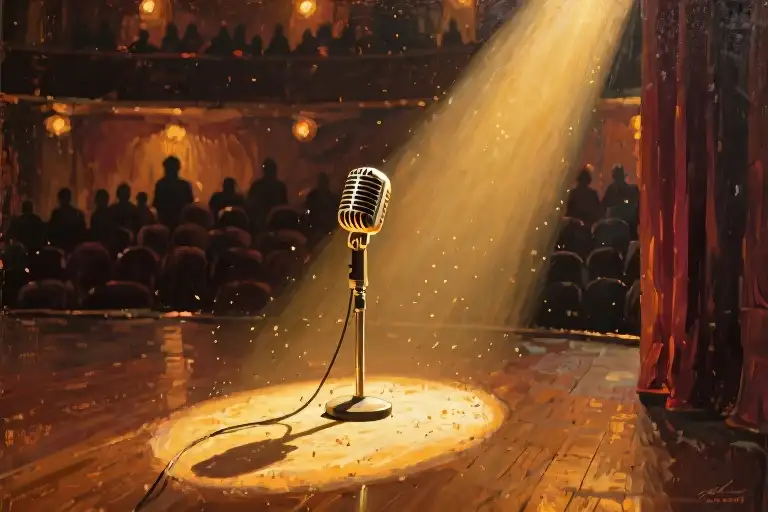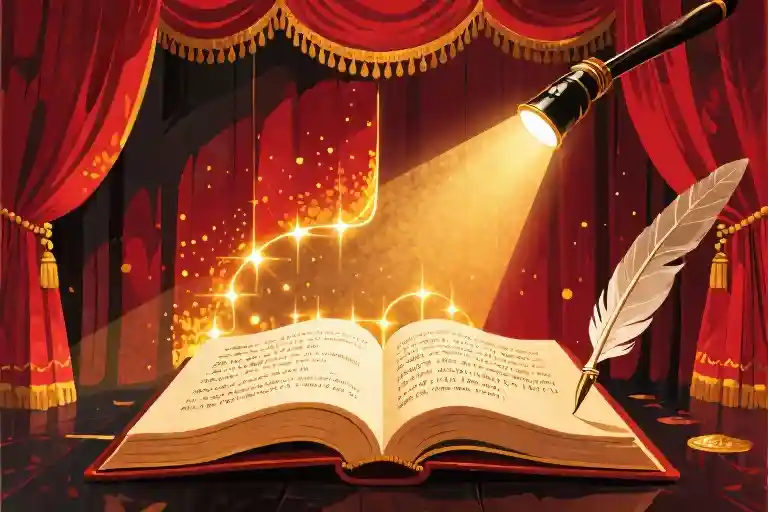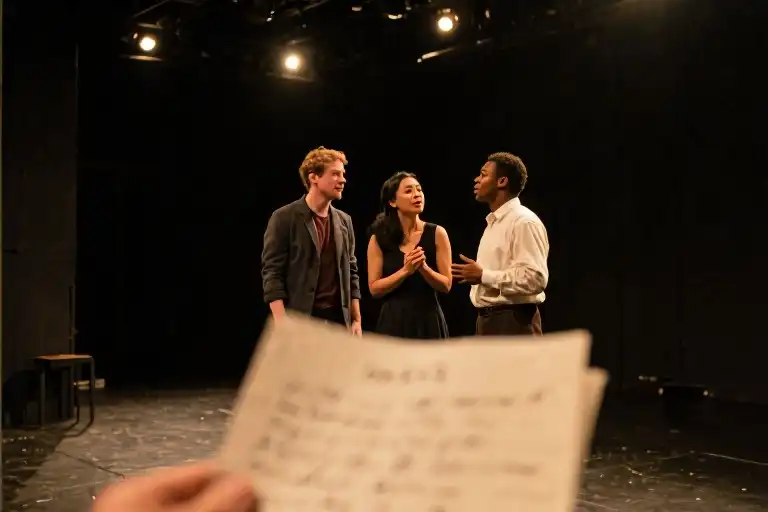The lights dim on Broadway as Denzel Washington steps into the spotlight, his shoulders bearing the weight of a 400-year-old tragedy that feels ripped from today’s headlines. This isn’t just another Shakespeare revival—it’s Othello reimagined for an era where conversations about race, toxic masculinity, and power dynamics dominate our cultural landscape.
Washington’s casting as the Moorish general sparks immediate recognition in modern audiences—a Black man navigating predominantly white spaces, his military brilliance constantly undermined by whispered prejudices. Across from him, Jake Gyllenhaal’s Iago slithers through scenes with the polished charm of a corporate climber, his ‘motiveless malignancy’ (as Coleridge famously called it) mirroring contemporary anxieties about trust in the post-truth age.
At its core, Othello remains Shakespeare’s most intimate tragedy—a handkerchief’s flutter unraveling a marriage, a few planted seeds of doubt blossoming into murderous rage. The 2024 production leans into these timeless elements while allowing new resonances to surface. When Iago hisses ‘I hate the Moor,’ the line lands differently in an America still wrestling with its racial ghosts. Desdemona’s helpless protest—’I never did / Offend you in my life’—carries fresh poignancy amid ongoing #MeToo reckonings.
What makes this revival particularly compelling isn’t just the star power (though Washington and Gyllenhaal deliver career-defining performances), but how director Sam Gold frames their interactions. The military barracks become a sleek corporate office; the famous ‘temptation scene’ plays out over whiskey in a hotel minibar. These subtle updates remind us that Shakespeare’s genius lay in capturing human nature’s constants—our capacity for love, jealousy, and self-destruction remain unchanged across centuries.
As you settle into your theater seat, notice how Gold uses modern dress to highlight the play’s enduring tensions. Othello’s crisp uniform contrasts with civilian clothes, visually reinforcing his outsider status. Emilia’s final act rebellion gains new urgency when delivered in a pantsuit rather than period skirts. Even the infamous pillow becomes a designer throw—domestic violence stripped of historical distance.
This production understands that great theater doesn’t just preserve classics—it makes them breathe with contemporary urgency. Whether you’re a Bard enthusiast or just Washington fan, you’ll leave with Shakespeare’s words echoing in your head and today’s newspaper stories flashing before your eyes.
From Italian Novella to Shakespeare: The Metamorphosis of a Revenge Story
That cautionary tale Shakespeare stumbled upon in his youth was Giovanni Battista Giraldi’s Un Capitano Moro (“A Moorish Captain”), published in 1565. The original narrative reads like a stern parental lecture – a beautiful Venetian woman named Disdemona (literally “the unfortunate one”) defies her family to marry the Moorish general, only to meet a brutal end when her husband, tricked by the scheming ensign, beats her to death with a sand-filled stocking. The moral? Obedient daughters live happily ever after; rebellious ones get bludgeoned.
What fascinates scholars is how Shakespeare transformed this moralistic fable during his creative peak around 1603. Fresh off penning Hamlet‘s psychological depths, the Bard took the novella’s cardboard characters and injected startling complexity. The unnamed Moor became Othello – a tragic figure whose eloquence (“Keep up your bright swords, for the dew will rust them”) contradicts Renaissance stereotypes of Black men. The one-dimensional villain gained layers in Iago, whose “motiveless malignancy” (as Coleridge noted) feels chillingly modern.
Three key innovations reveal Shakespeare’s genius:
- Psychological Realism: Where the original ensign acts from simple lust, Iago spins elaborate rationalizations (“I hate the Moor…”) that mirror real human self-deception.
- Sympathetic Victims: Desdemona evolves from a warning symbol into a fully-realized woman who defends her choices (“My heart’s subdued / Even to the very quality of my lord”).
- Cultural Tensions: The play amplifies the original’s racial undertones through Venice’s uneasy embrace of Othello – valued as a general but never truly belonging.
Comparing this to Shakespeare’s other “dark period” works shows his growing obsession with societal fractures. While Hamlet dissects political corruption and Measure for Measure explores sexual hypocrisy, Othello uniquely combines intimate betrayal with systemic prejudice – a cocktail that still intoxicates audiences four centuries later.
Fun fact: The original story specifies the murder weapon as a stocking filled with sand, a detail Shakespeare replaced with the now-iconic handkerchief – transforming a brutal act into a symbol of destroyed trust.
This creative alchemy explains why directors keep returning to Othello when racial tensions flare. As we’ll see next, the 2024 Broadway revival starring Denzel Washington doesn’t just restage a classic – it interrogates why this particular story resonates differently after movements like Black Lives Matter.
Why Now? Othello’s Contemporary Resonance
Denzel Washington stepping into Othello’s role isn’t just another celebrity casting—it’s a cultural reset button for a 400-year-old play that suddenly feels ripped from today’s headlines. This 2024 Broadway revival arrives at a moment when conversations about racial identity, toxic masculinity, and power dynamics dominate our social discourse, making Shakespeare’s tragedy vibrate with fresh urgency.
The Racial Reckoning in Casting Choices
Washington’s portrayal fundamentally shifts how we perceive the Moor of Venice. Historically, the role oscillated between two problematic traditions: white actors in blackface (like Laurence Olivier’s 1965 performance), or colorblind casting that diluted the racial tension. Director Sam Gold’s approach is different—he leans into the text’s racial subtext while dismantling stereotypes.
Key innovations in this production:
- Physicality: Washington’s Othello moves with the relaxed confidence of a man who’s earned his status, contrasting with the stiff formality of Venetian nobility
- Vocal Choices: The deliberate use of African American Vernacular English in private moments underscores cultural duality
- The Handkerchief Scene: Traditionally a symbol of stolen purity, here it becomes a metaphor for cultural appropriation as it changes hands
A recent New York Times analysis noted this production marks the first time in Broadway history where Othello’s race is neither exoticized nor minimized—it’s simply lived experience.
Iago for the #MeToo Era
Jake Gyllenhaal’s interpretation of Iago offers another revelation. Gone is the mustache-twirling villain—this Iago weaponizes male camaraderie, his misogyny simmering beneath workplace banter. The production highlights three contemporary parallels:
- Office Politics: Iago’s manipulation mirrors modern workplace gaslighting techniques
- Male Entitlement: His soliloquies about being passed over for promotion echo incel rhetoric
- Digital Age Deception: The handkerchief plot unfolds with the precision of a viral smear campaign
Social media has erupted with #OthelloMeToo discussions, particularly after the April 12th performance where Desdemona’s murder was staged as a domestic violence scenario with unsettling realism.
The Culture War Divide
Not everyone applauds these innovations. The revival has sparked heated debates:
Traditionalists argue:
- “Updating the context cheapens Shakespeare’s original intent” (Dr. Eleanor Whitmore, Cambridge)
- “Washington’s naturalism sacrifices the poetic grandeur” (The London Review of Theatre)
Progressives counter:
- “This is how Shakespeare would’ve wanted it—relevant to his contemporary audience” (Director Sam Gold in Vogue interview)
- “Finally, a production that doesn’t ask Black actors to perform whiteness” (#BroadwaySoWhite campaign)
The controversy itself proves the production’s success—it’s making 17th-century text feel dangerously alive. As you watch Washington and Gyllenhaal’s scenes together, you’re not just seeing great acting; you’re witnessing a 400-year-old conversation about power that’s still writing its next chapter.
The Othello Survival Kit: 3 Essential Tips for Modern Audiences
Attending a Broadway production of Othello can feel like entering a 400-year-old conversation that’s suddenly become urgent again. Whether you’re drawn by Denzel Washington’s star power or Shakespeare’s timeless prose, these practical strategies will help you navigate the emotional whirlpool of this classic tragedy with fresh eyes.
1. Decoding the Props: Handkerchiefs, Candles, and Daggers
Shakespeare never included random objects – every item carries layered symbolism that modern directors often amplify:
- The Strawberry-Handkerchief:
- Original Context: In Renaissance Europe, embroidered handkerchiefs symbolized female virtue and marital bonds. When Desdemona “loses” hers (Act III, Scene 3), it becomes visual proof of her imagined infidelity.
- 2024 Watchpoint: Notice how Washington handles the fabric – some productions have him sniff it compulsively, foreshadowing his mental unraveling.
- Candle Imagery:
- Look for moments when characters blow out candles (particularly in Desdemona’s bedroom scene). These deliberate lighting choices often represent the extinguishing of life or reason.
- The Dagger’s Double Meaning:
- When Othello calls his weapon “an honorable murderer” (Act V, Scene 2), the paradox reflects his fractured identity as both warrior and domestic abuser. Contemporary stagings sometimes replace the dagger with modern objects to highlight this tension.
2. The Physical Storytelling: A Body Language Timeline
Great Othello performances tell the story through movement as much as words. Here’s what to track:
| Act | Washington’s Othello | Gyllenhaal’s Iago |
|---|---|---|
| I | Open posture, calm gestures | Frequent shoulder touches (false camaraderie) |
| III | Tightened jaw, pacing | Sudden stillness during soliloquies |
| V | Trembling hands, uneven gait | Exaggerated eye contact with audience |
Pro Tip: Watch for “mirroring” moments where Iago subtly copies Othello’s movements before twisting them – a physical manifestation of manipulation.
3. Pre-Show Prep: Your 30-Minute Crash Course
Maximize your theater experience with these curated resources:
- Podcasts:
- Shakespeare Unlimited‘s “Othello and Blackface” episode (Folger Shakespeare Library) explains the casting history sensitively
- The Play Podcast breaks down key scenes with audio examples
- Visual Guides:
- The British Library’s online exhibit compares 17th-century promptbooks with modern scripts
- @ShakespeareGirl on TikTok demonstrates handkerchief symbolism in 60 seconds
- Post-Show Discussion Starters:
- “How did this production make the 1604 dialogue feel immediate?”
- “What modern parallels did you see in Iago’s manipulation tactics?”
Remember: There’s no “right” way to experience Othello. Whether you focus on the poetic language, the psychological drama, or the social commentary, you’re participating in Shakespeare’s enduring experiment about how easily love curdles into something darker.
The Timeless Mirror: Othello’s Modern Reflections
As the curtain falls on Denzel Washington’s powerhouse performance in the 2024 Broadway revival of Othello, audiences leave theaters not just entertained, but confronted with uncomfortable questions that transcend centuries. This final act of our exploration asks: why does a 400-year-old tragedy about a handkerchief still cut so deep in today’s world?
The Roots of Tragedy Revisited
Shakespeare’s genius lay in transforming a simplistic Italian cautionary tale into a psychological masterpiece. Where the original novella punished female disobedience, the Bard created:
- A racial outsider (Othello’s Moorish identity)
- An existential schemer (Iago’s motiveless malignancy)
- A love that defies categorization (Desdemona’s transgressive desire)
Modern productions like Washington’s highlight how these elements form a perfect storm of relevance:
| Era | Core Conflict | 2024 Resonance |
|---|---|---|
| 1604 | Interracial marriage taboo | #BlackLivesMatter discourse |
| 1604 | Military honor culture | Toxic masculinity debates |
| 1604 | Foreigner assimilation | Immigration politics |
Your Turn: The Audience as Jury
Consider these perspectives from the Lincoln Center lobby during intermission:
- “Washington makes Othello’s downfall feel like watching systemic racism in fast-forward” (College student, 21)
- “Jake Gyllenhaal’s Iago isn’t evil – he’s every guy who got passed over for promotion” (Marketing exec, 38)
- “That damn handkerchief? Today it’d be text messages” (Playwright, 54)
Continuing the Conversation
Before you share your take (we genuinely want to hear it – tag #MyOthelloTake), here’s food for thought:
- Nature vs Nurture: Is Othello doomed by his otherness, or does society create the monster it fears?
- The New Iagos: From algorithmic manipulation to deepfake technology, how have Shakespeare’s “honest villains” evolved?
- Desdemona 2.0: Could a modern adaptation give her more agency without betraying the text?
“The play’s the thing” – but the discussion it sparks might be even more valuable. Whether you’re Team #OthelloWasRobbed or #DesdemonaKnew, one thing’s certain: this isn’t your high school English teacher’s Shakespeare anymore.





